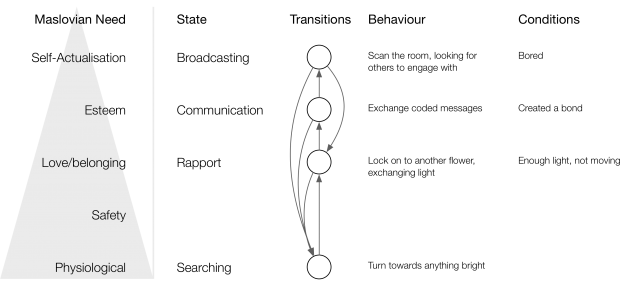Lichtsuchende
Lichtsuchende are light seeking robots, with a need for food, companionship and interaction, created in collaboration with Rocio von Jungenfeld. They won the Lumen Prize British Computing Society award for AI and Art (2019) and have been shown at ZKM (Exo-Evolution, 2015-16), New Technology Art Awards (2014), ACM Creativity and Cognition (Glasgow, 2015), Edinburgh Science Festival, Scottish National Gallery of Modern Art (2019).
The Lichtsuchende are small static robotic creatures, forming an interactive digital photo-kinetic sculpture. Their movement is modelled after sunflowers turning to face then sun, in their constant search for effulgent nourishment. As well as consuming light, they can produce light, giving possibilities of exchange and communication, and an ascension up Maslow’s hierarchy of needs. They are presented in the form of an interactive installation – a group of around 25 Lichtsuchende are placed in an otherwise dark room; participants enter with torches and engage with the robots, setting up cascades of movement and light, and exchanging photonic information with the cyber-society.

Papers
- von Jungenfeld, R., & Murray-Rust, D. (2023). Actor-Flower-Mesh-Work: Making Environments Together. In A. L. Brooks (Ed.), Creating Digitally: Shifting Boundaries: Arts and Technologies—Contemporary Applications and Concepts. Springer.
- Murray-Rust, D., & von Jungenfeld, R. (2017). Thinking through Robotic Imaginaries. RTD2017. https://doi.org/10.6084/m9.figshare.4746973
- Murray-Rust, D., & von Jungenfeld, R. (2015). Lichtsuchende: A Society of Cybernetic, Phototropic Sunflowers. Creativity and Cognition 2015. ACM.
- Murray-Rust, D., & Von Jungenfeld, R. (2016). Lichtsuchende. Interactions, 23, 14–15.
- Murray-Rust, D., & von Jungenfeld, R. (2015). Lichtsuchende : Exploring the Emergence of a Cybernetic Society. In C. Johnson, A. Carballal, & J. Correia (Eds.), Evolutionary and Biologically Inspired Music, Sound, Art and Design, 4th International Conference, EvoMUSART 2015 (LNCS 9027) (Vol. 1, pp. 161–174). Springer International Publishing.